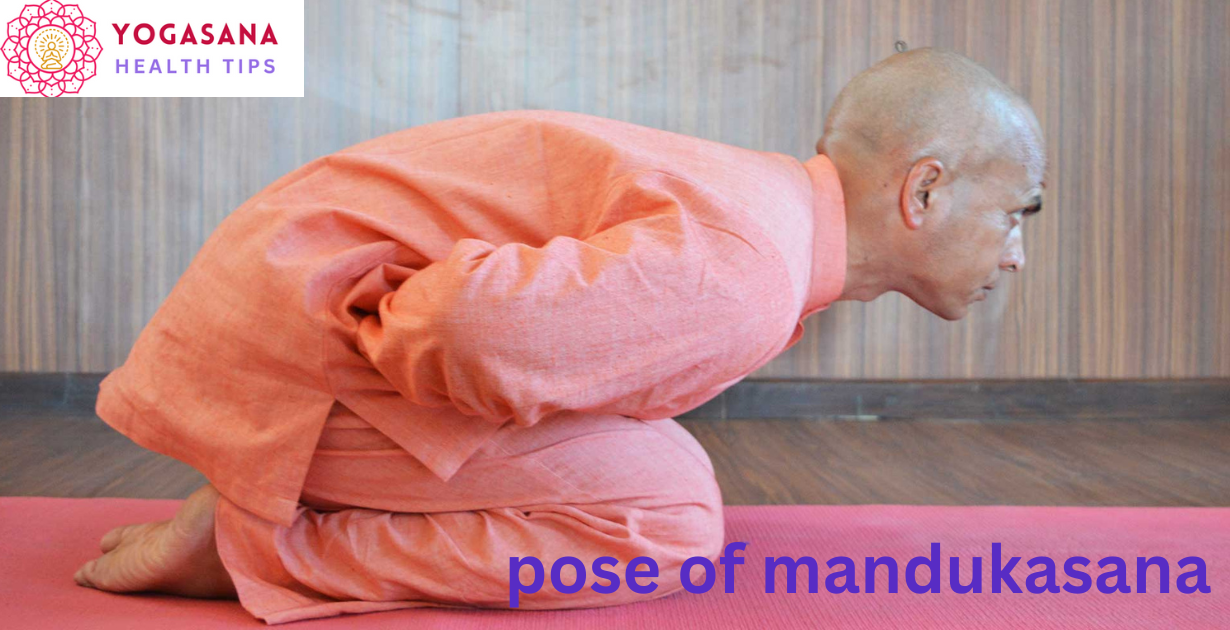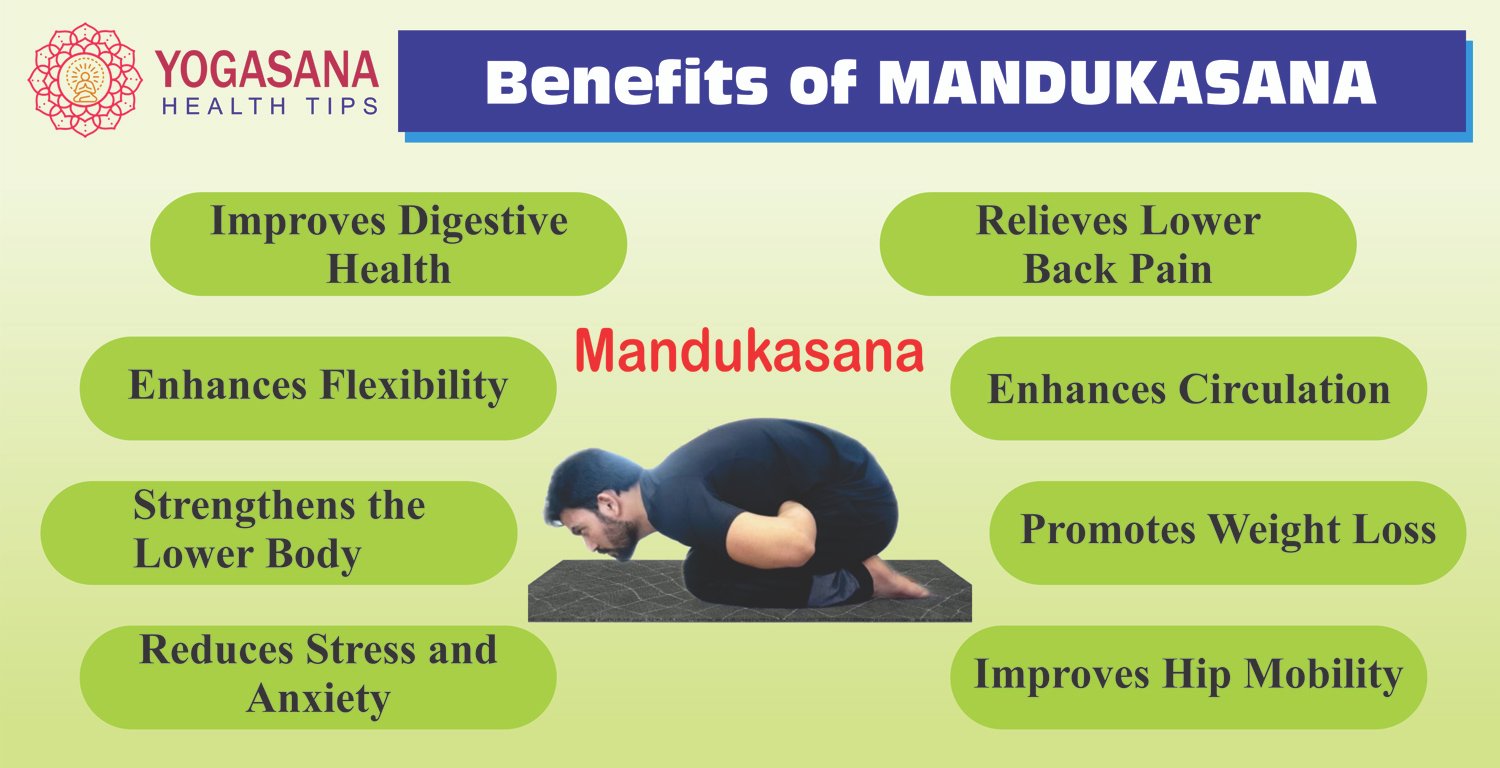Mandukasana’s Benefits__
What is Mandukasana (Frog Pose) ?
- Mandukasana, a sitting yoga pose that resembles a frog, is also referred to as the Frog Pose. This pose is a staple of many yoga programs because of its various health advantages, both physical and emotional.
- This pose promotes balance and relaxation in the practitioner by concentrating on the abdomen and enhancing digestion.
- The term “Mandukasana” originates from Sanskrit, where “Manduka” signifies frog and “Asana” denotes posture. This pose is appropriately named since it resembles a frog when performed correctly.

- These two Sanskrit words are combined to form the phrase “Mandukasana.” This position, which gives a tremendous stretch to the hips, thighs, and abdomen, is named after the frog’s crouch.
- The “Mandukasana’s Benefits” go beyond physical enhancements; they also include improved mental clarity, lowered stress levels, and general wellbeing.
- Adding Mandukasana to your yoga practice, whether you are a beginner or a seasoned practitioner, can help you become more flexible, increase your energy, and improve the way important organs like the stomach and pancreas work. Those with diabetes, indigestion, or stress can benefit most from this pose.
- By combining the right breathing methods with this asana, you can uncover the full “Mandukasana’s Benefits” and develop a more focused and aware yoga practice.
Mandukasana: A blessing for managing sugar(diabetes)__
- Combining regular Mandukasana practice with a nutritious diet and lifestyle modifications can help manage diabetes.

- Mandukasana is well renowned for its capacity to activate the pancreatic, an organ necessary for the generation of insulin.
- This pose can assist enhance insulin release and manage blood sugar levels by gently pressing on the pancreas and massaging the abdomen area.
- When done regularly, this is one of the most beneficial “Mandukasana’s Benefits” for people who are managing their diabetes.
For Whom Is Mandukasana Practice Necessary ?
- The Frog Pose, also known as Mandukasana, is very helpful for people who are having digestion problems or who want to increase their hip flexibility.
- Regular practice can help those with diabetes because it stimulates the pancreas, which helps control insulin levels.
- For those who want to improve their stomach and core muscles, this pose is also perfect. Among the “benefits of Mandukasana” include the reduction of abdominal fat, improved blood circulation, and constipation relief.
- It can be particularly beneficial for people who have lower body stiffness, encouraging more movement in the back and legs.
- Those who have serious hip or knee issues, however, should proceed cautiously with this stance.
A special Mandukasana’s Benefits_(Encourages Loss of Weight)__
- Another key “Benefits of Mandukasana” is its role in supporting weight loss.

- This pose can help increase the rate at which calories are burned by increasing metabolism and stimulating the digestive system.
- Mandukasana can assist in controlling body weight when paired with other physical activities and a well-balanced diet.
- Because of these “Mandukasana’s Benefits”, it’s a very beneficial addition to any yoga practice that improves mental and physical health.
How to Perform Mandukasana (Frog Pose) Step-by-Step__
- Practicing Mandukasana (Frog Pose) is simple but requires patience and the right technique to fully experience the “Mandukasana’s Benefits”. Here’s a quick guide:
- Start by sitting in Vajrasana (Thunderbolt Pose) with a straight back and your hands resting on your thighs. Gently spread your knees apart while keeping your toes together and heels separated. This prepares your hips for the deep stretch of Mandukasana.
- Next, place your fists near your navel, pressing gently into your abdomen. As you exhale, bend forward from your waist, keeping your back straight. This creates a gentle massage for your abdominal organs, especially helping with digestion.
- Hold this position for 20 to 30 seconds while taking deep, slow breaths. Gradually return to Vajrasana and repeat 2 to 3 times. Regular practice can improve flexibility, help manage diabetes and indigestion, and stimulate the pancreas, enhancing the overall “Mandukasana’s Benefits”.
Some Precautions about Practicing Mandukasana__
- Safety Measures for Doing Mandukasana
Although there are many “Mandukasana’s Benefits” (Frog posture), including better digestion, stress relief, and increased flexibility, it’s crucial to perform this posture carefully. The following are some safety measures to remember: - Knee Pain or Injury:Mandukasana exerts strain on the knees; therefore, practitioners should either modify their practice to avoid this posture or use knee pads. If discomfort develops, cease right away.
- Pregnancy:Mandukasana should not be performed by expectant moms since it compresses the stomach area, which may cause discomfort or other issues.
- Lower Back Problems:Use caution when using this pose if you have previously experienced lower back pain. Avoiding strain can be achieved by using the core muscles to support the spine. On the other hand, you should avoid this stance if you experience any sharp pain.
- High Blood Pressure:Because Mandukasana requires forward bending, which can impair circulation, people with high blood pressure should only do the pose carefully and under the supervision of a trained instructor.
- Pay Attention to Your Body:Consciously practice and refrain from overextending yourself. In order to avoid injury, it’s crucial to ease into the posture rather than pushing your body.
- You can safely benefit from the “Mandukasana’s Benefits”, such as better digestion, enhanced flexibility, and stress release, by taking certain measures. Always consult a yoga instructor or healthcare professional if unsure about any poses.
Aditional Most Important Benefits of Mandukasana(Frog Pose)__
- Frog Pose, also known as Mandukasana, is a potent yoga pose with numerous health benefits.
- This stance works the body’s muscles, promoting mental, emotional, and physical well-being. The top five “Mandukasana’s Benefits” are as follows:

Enhances Digestive Health
- Improving digestion is one among the most well-known “Mandukasana’s Benefits”.
- The posture stimulates the digestive organs, including the stomach, intestines, and liver, by applying light pressure to the abdomen.
- Common digestive problems including bloating, indigestion, and constipation are relieved by this. Regular exercise can eventually result in a healthier and more effective digestive tract.
Reduces Tension and Encourages Mental Serenity

- Mandukasana has advantages for mental health in addition to physical health.
- The pose promotes attention and deep breathing, which ease tension and assist to quiet the mind.
- It’s a terrific way to relieve stress since the practice of holding the pose while concentrating on the breath helps improve mental clarity and relaxation.
Increases the thighs’ and hips’ flexibility
- The hip-opening pose known as mandukasana extends the groin, hips, and thighs.
- This improved flexibility benefits yoga practice as well as reducing tension brought on by prolonged sitting or inactivity.
- Frequent exercise can increase range of motion in these regions, which enhances physical agility overall.
Improves the flexibility of the hips and thighs
- The “Mandukasana’s Benefits” go beyond the traditional benefits of yoga poses; they provide special advantages for mental and physical well-being.
- By massaging the abdominal organs, this pose is very helpful for promoting digestion and reducing constipation and bloating. It’s also a great asana for diabetes management because it stimulates the pancreas.
- Mandukasana also improves the flexibility of the hips and thighs, which helps to relieve stress and increase mobility.
- As a mental aid for relaxation, stress reduction, and mindfulness enhancement, it is a comprehensive supplement to any yoga practice for general well-being.
Conclusion:
Including Mandukasana, also known as Frog Pose, in your yoga practice can have a profoundly positive impact on your mental and physical health. Practicing this asana is a great way to manage illnesses like diabetes because it helps to stimulate the pancreas and improve digestion. Mandukasana also contributes to a reduction in tension and an improvement in mental clarity by enhancing hip and thigh flexibility. The “Mandukasana’s Benefits” include stronger digestion, increased flexibility, and a more balanced mind; hence, it is a necessary component of any yoga practice when done correctly and with awareness.
FAQ:
Which “Mandukasana’s Benefits” are they ?
Despite its various advantages, mandukasana is thought to be particularly beneficial for joint pain. Aside from this, yoga is a particularly beneficial practice for conditions like diabetes and for increasing bodily flexibility. It also helps women with issues pertaining to their menstrual cycles.
How many times a day should one perform Mandukasana ?
It is beneficial to perform Manduk Asana three times a day on an empty stomach. Manduk Asana is ideally performed right after waking up in the morning.
Who is not suited for Manduk Asana ?
This pose should not be done by anyone who have had stomach surgery or who are experiencing stomach pain. Manduk Asana should not be practiced by someone who has navel issues.
Is abdominal fat reduced by Mandukasana ?
Manduk Asana decreases fat in the stomach and lower abdominal area because it puts a lot of pressure on the stomach. because it puts pressure on the stomach, which aids in the loss of fat that has been accumulated there.
How long after consuming food should one perform Mandukasana ?
Because mandukasana puts a lot of pressure on the stomach when performed, it is best done on an empty stomach, thus you can perform it five to six hours after eating.

